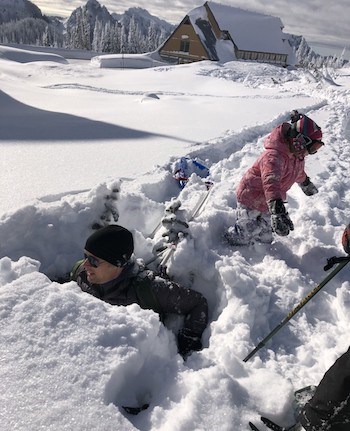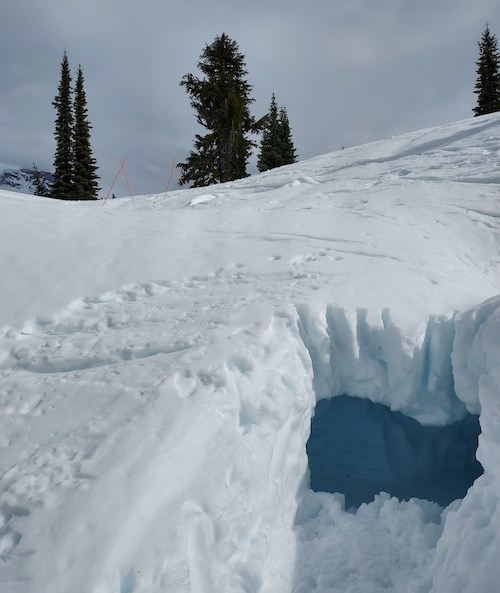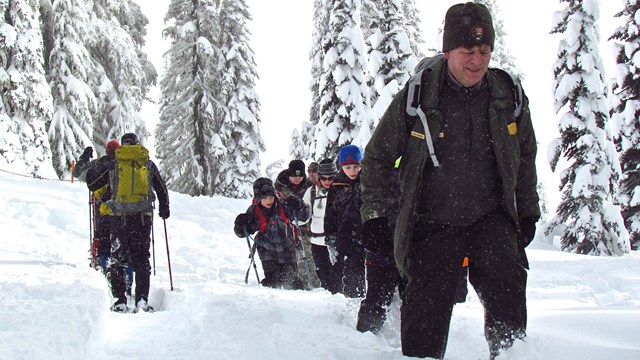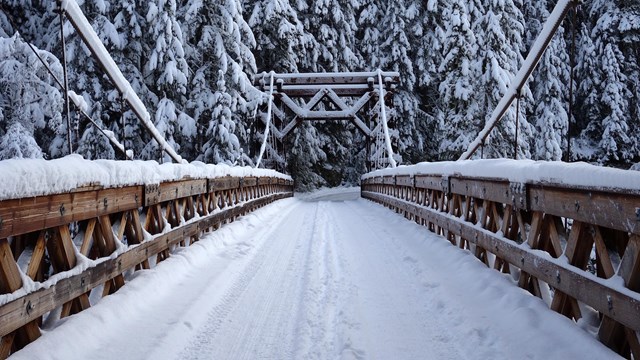
NPS Photo Known for its deep snowpack, “winter” conditions on Mount Rainier can last well into June or July with snow-covered trails at higher elevations. Additional safety tips can be found on the Spring Hiking Safety page. WeatherBe aware that mountain weather changes rapidly - a pleasant outing can quickly be transformed into a survival ordeal. Navigation in harsh winter conditions can be extremely difficult. It is usually better to camp and wait for clearing weather than to continue and risk becoming lost. For more information on weather, including current forecasts, go to the weather page. Are you prepared to be a weather-ready explorer? Short DaysDays are short during the winter, with sunrise around 8:00 am and sunset before 4:30 pm on the shortest days of the year. There are only 8 hours and 25 minutes of daylight on the winter solstice compared to almost 16 hours of daylight on the summer solstice! With less daylight, and more challenging conditions due to snow and other winter hazards, do not expect to cover the same distance as is possible on a summer trail. Adjust plans accordingly and be prepared to overnight if needed. RoadsBefore leaving home, make sure that you're ready for driving winter roads. To see which roads are open, check the Road Status page. The park webcams can give you a good idea how conditions look. Also, the latest updates about the Longmire to Paradise Road opening times and tire chain requirements will be posted as Alerts. Winter 10 EssentialsBackcountry skiers, snowshoers, and campers should be equipped to survive nights out if whiteout conditions prevent travel. Carry the Winter 10 Essentials and know how to use them:
Learn more about winter recreation. IceRoads, sidewalks, and trails in the park are often icy during the winter and spring months. Take care when walking and use traction devices like shoe chains or traction cleats to avoid slips and falls. If a trail is too icy or you are unprepared, turn around. Some trails have steep drop-offs that can be extremely hazardous if you fall. AvalanchesAvalanches are most common during or immediately after a storm. Never travel or camp in an avalanche zone. Stop at the Longmire Information Center or Jackson Visitor Center for weather and avalanche hazard forecasts, maps of areas to avoid, and general avalanche information. For local avalanche forecasts and other important information, visit the Northwest Weather and Avalanche Center. TranscriptMy name is Glenn Kessler, Supervisory Climbing Ranger at Mount Rainier. The avalanche risk on Mount Rainier for visitors exists sort of two times- two different heights of the year. One is the winter season as we have right now where we get a fair amount of new snow on the mountain. Upper mountain, lower mountain, we just get a lot of snow. The primary avalanche season is the winter time. We tend to have storms that bring in avalanche danger and they’re direct action storms, and by that I mean when the amount of snowfall increases that’s when our avalanches generally happen. Snow time- or I should say if we have snowfall- we have a storm; as the storm starts the avalanche danger slowly rises, and then rapidly rises once we get six to eight to ten inches of snow. Often we’re stable on the lower mountain here within about 48 hours, although that’s only when the Northwest is acting like the Northwest, and it’s generally mild temperatures and deep snowpack. On the upper mountain that danger can linger for weeks. So that’s the main season, is basically December or late-November through the end of winter. Then comes a secondary season in between when the skiers sort of take off and then our climbers come out in force and start heading out on the upper mountain. So we get a secondary season when the climbers come out and the seasons change such that the snow that’s already fallen, plus some new snow possibly, and the warm temperatures of spring-time start to melt the snow that’s on the mountain, and then we get a lot of spring avalanches which can happen directly after small storms or even larger avalanches as water percolates through that snowpack that’s been around all year long, and we can have this secondary season and have some pretty large avalanches based on that. Today we have good weather and the only reason why the avalanche danger at this level has gone down to moderate and considerable just above here- moderate here at tree-line and considerable above- is that we’ve actually had a couple of days without snow. So, if you’ve got a big storm and that ends pretty pronto right after the large part of that snowfall and the sun comes out, we could have just a morning after a big snow storm and that’s a tough time because people know- they watch the weather, they watch the news and they know when that good weather is coming and what they don’t pay attention to is just cause you got good weather does not mean avalanche conditions aren’t bad. Looking at the Northwest Weather and Avalanche Center website, making sure you are up on what’s going on. If that website is down for the year, which happens towards the April period of time, check with the Park Service and find out what’s gone on as far as the avalanche danger. However, the avalanche centers can only basically do a forecast for about seven thousand feet or so. And here on Mount Rainier we’re already at fifty four hundred here at Paradise right now and seven thousand feet is the top of Pan Point which is not too far. Our visitors very often in the wintertime and the summertime are going well beyond seven thousand feet, so those avalanche reports have to be read and understood that they’re for a limited amount of terrain and the reports specifically say they are not valid for higher elevations on the volcanic peaks, such as Mount Rainier, Mount Hood, Baker, Shuksan, etc. So you’ll have to do your own investigation once you leave that seven thousand foot level or so. The roads on Mount Rainier are generally deemed safe when they’re open. You got to still be really careful on the roadways cause we do have some treacherous mountainous roads that there’s no way to make them completely safe from drivers that don’t adhere to speed limits, etc. But if the roads are open they’re deemed to be safe enough that avalanches should not be hitting the roads. We do very little control work but we try not to open the roads when lingering avalanche danger is there. If the avalanche danger is still there but not for large avalanches the roads may be open as long as we’ve got road crew on that can dig out whatever avalanches end up on the road. So, if you come to the park you may also find the road’s closed at times when there’s high avalanche danger because we simply can not open the roads. And that’ll often happen from about mid-winter towards ‘til the end of winter.
Visit our keyboard shortcuts docs for details
Anyone familiar with mountains knows that avalanche danger is always a consideration when heading out for a snowshoe walk or ski trip. Mount Rainier is no exception. In this Ranger Brief video, Climbing Ranger Glenn Kessler discusses avalanche risk and safety on Mount Rainier. 
NPS/D. van der Elst Photo Snow HazardsIn addition to avalanches, watch out for other hazards like snow bridges. Snow BridgesSnow bridges are created when snow covers a creek or stream, hiding the water from view. Falling through into the water can cause injury, hypothermia, or death. Fast moving streams can sweep you away under the snow making it difficult to escape. The Ranger Brief: Shoulder Season Hazards video describes the risks of snow bridges in more detail.
Snow CornicesA snow cornice is an overhanging edge of snow that develops on the downwind side of ridges and summits. Cornices are difficult to identify from the top of a ridgeline as it may appear that the ground continues underneath although the snow is just built up on itself. As stated by the National Avalanche Center, “Even a small cornice can be deadly if it carries you over a cliff or rocky terrain below”.
Tree WellsTree wells are a primary winter hazard in the Paradise area or anywhere with deep snow. Falling into one can cause injury or quickly turn into a deadly situation. Tree wells are hidden cavities of unconsolidated snow under the lower branches of trees and vegetation that are not visible on the surface. Falling into one of these hidden wells upside-down can quickly cause suffocation or positional asphyxiation. Add snowshoes or skis to the mix, and it can be impossible to self-rescue.
HypothermiaWhen exposed to cold temperatures, the body begins to lose heat faster than it can be produced. The result is hypothermia, or abnormally low body temperature. A combination of cold weather, wet snow, and wind can easily rob a person of essential body heat. If left untreated, hypothermia can lead to unconsciousness and death. Low body temperature affects the brain, making the victim unable to think clearly or move well. Some signs of hypothermia include shivering, memory loss, exhaustion, slurred speech, confusion, drowsiness, and fumbling hands. The best way to avoid hypothermia is to be prepared by checking the weather forecast and planning accordingly. To Prevent Hypothermia:
GlissadingGlissading is sliding down a snow-covered slope on your butt while using your feet or a tool like an ice axe to control the slide. While glissading seems like a fun and easy way to descend slopes, it is not sledding, and it can pose hazards to not only you, but also to others heading up the hill. Before you head up into steeper terrain in the park, like Panorama Point at Paradise, make sure you are prepared to come down. Do you have a tool like an ice axe, and do you know how to use it? Are you wearing clothes, such as waterproof pants and gloves, to protect yourself from the snow? Snow can be surprisingly abrasive.

NPS Photo SheltersSnow caves, tents, and igloos can provide shelter from the elements, but be sure your shelter has adequate ventilation to prevent carbon monoxide poisoning. Maintain good ventilation while cooking, as cooking in a shelter will consume oxygen rapidly. To maintain adequate ventilation during snowy, windy conditions, you will need to go outside to dig out your tent or clear igloo vents. 
Spring Hiking Safety (April-June)
It's easy to underestimate the hazards of hiking at higher elevations still covered in snow. Follow these tips for safely hiking on snow. 
Winter Recreation
Come play in the snow! Mount Rainier offers a variety of winter recreation options, from snowshoeing to winter camping. 
Winter Travel
Be prepared for winter travel, when roads can be closed or have quickly changing conditions. |
Last updated: March 6, 2025
